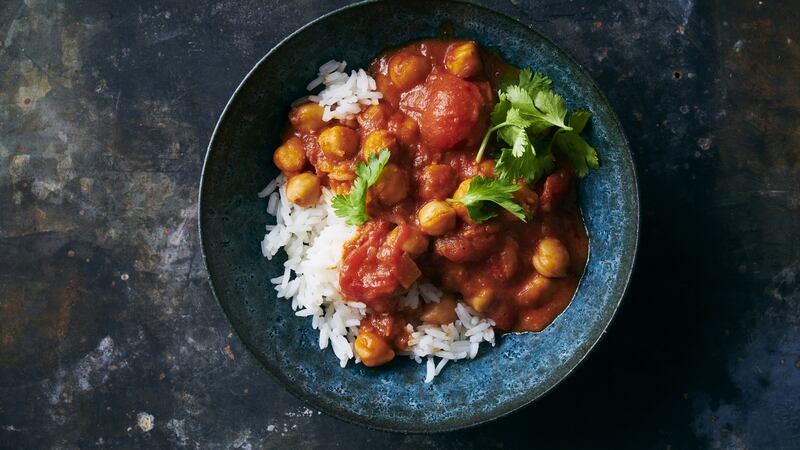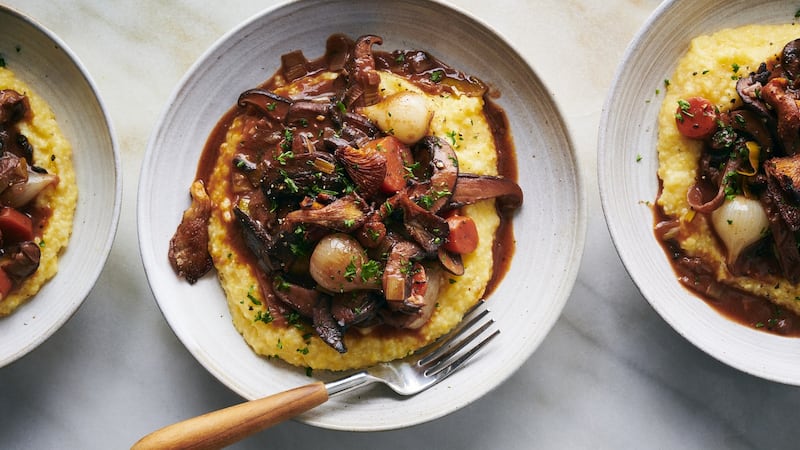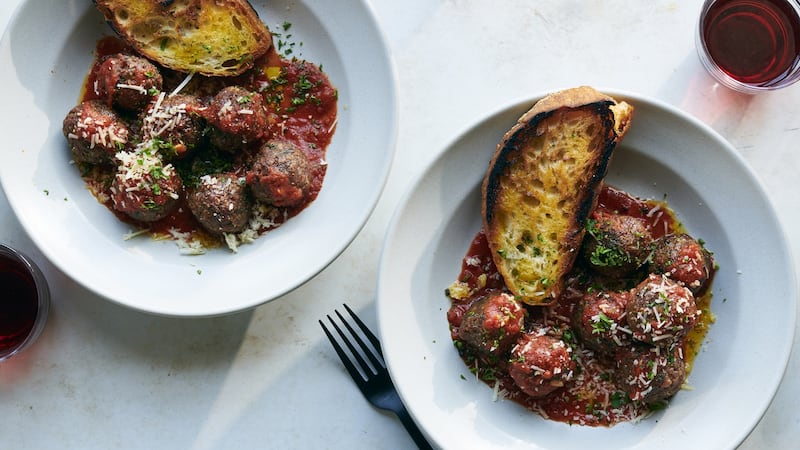For all of my adult life, I’ve revelled in rare rib-eye steaks and oozing Camembert. I won’t let go of my drumstick until I’ve gnawed off every bit of cartilage and golden skin, and it’s best to not even talk about bacon so crisp that it won’t bend for that first porky bite.
Yet over the past few months, I’ve cut way down on my lamb chops and grilled cheese sandwiches. And if you’re a meat-and-dairy eater who aches over the environmental state of our planet, then you may be thinking of doing the same thing, too.
I’d always considered my food choices to be outside the problem. I get a local farm box of produce every week, and frequent the farmers’ market for more vegetables, as well as grains and ethically raised meat. I limit seafood that’s not sustainable, and when I do shop at a supermarket I mostly fill my cart with organic whole foods that are not highly processed (the occasional bag of Cheetos aside).



I don't know that I've got the willpower to stick to a vegan or vegetarian diet. I love meat and dairy too much to give them up entirely. But eating less of them – that I can do
Evidence is piling up, though, that this isn’t enough to make an impact. Only drastic changes will make a difference. The World Resource Institute, an environmental research group, recommends that wealthy nations cut their beef, lamb and dairy consumption by 40 per cent to meet global emissions goals for 2050.
Becoming vegan could be the most planet-friendly way to go, followed by going vegetarian. In my case, those diets would be a professional liability, and to be perfectly honest, I don’t know that I’ve got the willpower to stick to either one. I love meat and dairy too much to give them up entirely. But eating less of them – that I can do.
On the upside, eating less meat and dairy means there is more room on my plate for other delectable things: really good sourdough bread slathered with tahini and homemade marmalade, mushroom Bourguignon over a mound of noodles, and all those speckled heirloom beans I keep meaning to order online.
So how much meat and dairy should we actually be eating? And if we reduce our intake severely, do we then need to worry about getting enough protein?
According to Marion Nestle, an author and professor emeritus of nutrition, food studies and public health at New York University, if you are getting enough calories, then you are getting enough protein. (That is, unless you are an elite athlete.)
After some mental calisthenics, I landed on trying to limit myself to two to three meals that include meat, seafood or dairy per week, and thrice-daily splashes of milk in my tea (non-negotiable if I want to retain my sanity). I figure this is about a 40 per cent reduction from the six to eight meaty, cheesy, anchovy- and yogurt-laden meals I had been eating weekly. (The rest were already meat- and dairy-free, and I don’t typically eat breakfast.)
Another way to strategize is to try keeping the daily mix of what you eat to 80 per cent plant matter and 20 per cent meat, dairy and seafood. (Going vegan all day, then having a small amount of meat or cheese with dinner is one way that people make this work.)
For my meat allotment, I’ve focused more on chicken, pork and local seafood (especially molluscs), which are generally less taxing to the environment than beef and lamb, both of which are now relegated to special-occasion status.
I like to loosely think of my approach as mindful meat-eating. Now, when I do simmer up a pot of ribs, I'm thoughtful and deliberate about it, which makes it taste even more delicious
Of course, none of this is in any way a novel approach. The concept of flexitarianism has been around since the early 2000s, and it’s a central tenet in much of Michael Pollan’s writing. But somehow the term seems timeworn, and not at all evocative of the pleasures of the table.
I like to loosely think of my approach as mindful meat-eating. Now, when I do simmer up a pot of beef short ribs (or smear cream cheese on my bagel, or go for sushi), I’m thoughtful and deliberate about it, which makes it taste even more delicious, seasoned with anticipation.
And while the days of absent-minded chicken Caesar salads and oblivious cheese-and-cracker munching are for the most part over, the likes of avocado toast, salted cashews and popcorn covered with coconut oil and nutritional yeast can fill the void.
What follows is my own personal guide to eating less meat, and dairy too, with tips, strategies and plenty of recipes.
1. Eat beans and more beans
We are a family of bean lovers, so adding more of them to our weekly menu makes for happiness all around. To keep us from getting bored, though, I've widened the net, seeking out less common varieties, along with my usual roster of chickpeas, lentils and cannellini.
I’ve also changed the way I think about chilli, one of my go-to bean-based meals. I used to add a small amount of ground meat to my chilli pot as a matter of course, unless I was making a specifically vegetarian chili. Now, I usually skip the meat – save for the occasional spoonful of bacon grease or lard for richness – and I don’t miss it.
Beans are also excellent stand-ins for meat in certain recipes, like using chickpeas in a riff on Indian butter chicken, and filling tacos with black beans instead of pork. And there’s an entire universe of dals that I’m continuing to explore.
2. Turn to high-protein grains (pasta counts!)
Yes, there's quinoa, the quick-cooking staple that fills many a grain bowl. But there's also kamut, teff, millet, wild rice, buckwheat, cornmeal and even pasta. Grains have a lot more protein than we often give them credit for, along with a host of other vital nutrients, especially when we eat them whole. (I'll always have a soft spot for white rice, though, whether it's steamed sticky rice, or basmati pilaf, or Carolina long-grain rice cooked into pudding.)
Grain bowls make diverse, ever-changing meals that I can throw together from whatever is in the fridge, anything from leftovers to condiments or both. These days I find myself putting together a grain bowl at least once a week, topped with roasted vegetables and some kind of savoury sauce to bind everything together. These bowls never get boring.
But within this category, pasta is my first choice, and I adore it in every incarnation. And using toasted breadcrumbs in place of Parmesan keeps the dairy quotient down, too.
3. Elevate your tofu game
Whether pillow-soft and fluffy or crisp-edged and browned, tofu is always welcome on my plate. This is not the case for the rest of my family, who give it the side-eye whenever I serve it. The trick in our house has been to pair tofu, which has a relatively neutral taste, with ingredients with pizazz – the more umami-intense, the better. Miso, soy sauce, mushrooms, hot sauce and fermented black beans do a lot of the heavy lifting.
Another strategy is to mix in a small amount of meat – ground chicken or pork, or a little bacon – to add a large amount of flavour. Cooking it all on a sheet pan makes for an easy weeknight meal.
4. Embrace nuts and seeds
I could sing the praises of toasted nuts, nut butter and tahini here, but you probably already know everything you need to about them. Whether toasted and chopped so they're satisfyingly crunchy, or puréed and seasoned to become alluringly creamy dressings or sauces, nuts and nut butters are a great way to round out a plate of roasted, steamed or raw vegetables.
What I really want to talk about is my newfound love of homemade vegan cheese (though I won’t turn my nose up at store-bought nut-based queso dip, either). The best recipes I’ve tried are made from cashews, ground up with nutritional yeast and all manner of seasonings (smoked paprika, garlic powder, oregano), and then set with agar powder.
No, they don’t taste anything like actual cheese. But when I rush home, ravenous and stressed after work, and there’s some in the refrigerator that I can heap onto my Wheat Thins and nibble with my glass of wine, I don’t miss Stilton nearly as much as I’d feared.
5. Consider plant-based meats
There's no denying how processed most vegan meats are, loaded with unidentifiable ingredients, but they do scratch the itch for burgers and meatballs. And plant-based sausages remind me of kishke, a traditional Jewish and Eastern European sausage made with beef and bread or grains, in a very good way. These products are often a starting point for people who want to cut down on their meat intake – and, with some brands, once that faux burger patty is stuffed into a bun and loaded with condiments, it may be hard to tell the difference.
6. Make every bite of real meat count
Now that I'm eating less meat, every single morsel of it needs to hold its own. Which means I'm less likely to bother with a chicken breast when a smaller amount of Italian turkey sausage, sautéed until crisp and strewn over my spinach salad, delivers a lot more oomph. Or how about some duck confit? Assertively flavoured cured pork – bacon, salami, prosciutto – add salty brawn to roasted vegetables and grains, pastas and salads, and a little goes a long way.
Then there’s good, concentrated broth, whether it’s bone broth or otherwise. Using beef broth in mushroom Bourguignon contributes tons of savoury character without adding any actual meat. And making bone broth from scratch with the leftovers of your blowout prime rib helps, at least a tiny bit, with the severe problem of food waste. But really, make it because it tastes good.
MEAT-FREE MEALS
Mushroom Bourguignon
Serves four to six
Meaty mushrooms simmered with pearl onions, wine and carrots make for a rich, wintry Bourguignon-style stew. The quality of the stock here makes a big difference, so if you're not using homemade, buy a good brand. If you're a meat eater, beef broth adds a familiar brawny character to this dish, but mushroom or vegetable broth work just well, especially because the whole dish is rounded out with a tamari for depth. For the best flavour, use as many kinds of mushrooms as you can get, and let them really brown when searing; that caramelization adds a lot of depth to the sauce. Maitake mushrooms give this a brisketlike texture, in a very good way.

Ingredients
6 tbsp butter or extra-virgin olive oil, plus more as needed
900g mixed mushrooms, such as portobello, cremini, white button, shiitake or oyster, cut into 1-inch chunks
225g peeled pearl onions , larger ones cut in half
Salt and freshly ground black pepper
1 large leek or 2 small leeks, white and light green parts, diced
2 carrots, thinly sliced
3 garlic cloves (2 minced, 1 grated to a paste)
1 tbsp tomato paste
2½ tbsp all-purpose flour
350ml dry red wine
350ml beef, mushroom or vegetable broth
1 tbsp tamari or soy sauce, plus more to taste
3 large fresh thyme branches or ½ tsp dried thyme
1 bay leaf
110g chanterelle or oyster mushrooms, thinly sliced
Smoked paprika, for serving
Polenta, egg noodles or mashed potatoes, for serving
Chopped flat-leaf parsley, for serving
Method
1. Add two tablespoons butter or oil to a large heavy based pot or casserole and set it over medium heat. When the fat is hot, stir in half the mushrooms and half the pearl onions. (If it doesn't all fit in the pot in one layer, you might have to do this in three batches, rather than two.) Without moving them around too much, cook the mushrooms until they are brown on one side, about three minutes. Stir and let them brown on the other side, two to three minutes more. Use a slotted spoon to transfer mushrooms and onions to a large bowl or plate and sprinkle with salt and pepper. Repeat with another two tablespoons butter and the remaining mushrooms and pearl onions, seasoning them as you go.
2. Reduce heat to medium-low. Add another tablespoon butter or oil to pan. Add leeks and carrot and sauté until the leeks turn lightly golden and start to soften, five minutes. Add the two minced garlic cloves and sauté for one minute longer. Stir in tomato paste and cook for one minute. Stir in flour and cook, stirring, for one minute, then add wine, broth, one tablespoon tamari, thyme and bay leaf, scraping up the brown bits at bottom of pot.
3. Add reserved cooked mushrooms and pearl onions back to the pot and bring to a simmer. Partly cover the pot and simmer on low heat until carrots and onions are tender and sauce is thick, 30 to 40 minutes. Taste and add more salt and tamari if needed. Stir in the grated garlic clove.
4. Just before serving, heat a small frying pan over high heat and add a half tablespoon butter or oil. Add half of the sliced chanterelles or oyster mushrooms and let cook without moving until they are crisp and brown on one side, one to two minutes. Flip and cook on the other side. Transfer to a plate and sprinkle with salt and smoked paprika. Repeat with remaining butter and mushrooms. Serve mushroom Bourguignon over polenta, noodles or mashed potatoes, topped with fried mushrooms and parsley.
INDIAN BUTTER CHICKPEAS
Serves four to six
A vegetarian riff on Indian butter chicken, this fragrant stew is spiced with cinnamon, garam masala and fresh ginger, and is rich and creamy from the coconut milk. You could add cubed tofu here for a soft textural contrast, or cubed seitan for a chewy one. Or serve it as it is, over rice to catch every last drop of the glorious sauce. You won't want to leave any behind.

Ingredients
4 tbsp unsalted butter
1 large onion, minced
1½ tsp salt, or to taste
4 garlic cloves, finely grated or minced
1 tbsp grated fresh ginger
2 tsp ground cumin
2 tsp sweet paprika
2 tsp garam masala
1 small cinnamon stick
1 tin whole peeled plum tomatoes
1 tin coconut milk
2 tins chickpeas, drained
Ground cayenne (optional)
Cooked white rice, for serving
Coriander leaves, for serving
Method
1. Melt butter in a large heavy-bottomed pot or casserole over medium heat. Stir in onion and ½ teaspoon salt; cook until golden and browned around the edges, stirring occasionally, about 20 minutes. (Don't be tempted to turn the heat up to medium-high; keeping the heat on medium ensures even browning without burning the butter.)
2. Stir in garlic and ginger, and cook another minute. Stir in cumin, paprika, garam masala and cinnamon stick, and cook another 30 seconds.
3. Add tomatoes with their juices. Using a large spoon or flat spatula, break up and smash the tomatoes in the pot (or you can use a pair of kitchen shears to cut the tomatoes while they are still in the tin). Stir in coconut milk and the remaining teaspoon salt. Bring to a simmer, and continue to cook for 10 minutes, stirring occasionally, and continuing to mash up the tomatoes if necessary to help them break down.
4. Stir in chickpeas and a pinch of cayenne if you like. Bring the pot back up to a simmer and cook, stirring occasionally, for another 10 minutes. Taste and add more salt if necessary.
5. Serve spooned over white rice, and topped with cilantro.
MEATLESS MEATBALLS IN MARINARA SAUCE
Serves four to six
These "meatballs" use plant-based ground meat, and a combination of onions, garlic and tamari give them a satisfying chew and robust flavour. Because there's no egg for binding, these are slightly more delicate than other meatballs, so use a light touch when shaping them, and make sure the mixture is very cold. Serve them on their own, covered in tomato sauce, or stuff them into rolls for sandwiches. They are also excellent over spaghetti.

Ingredients
60g panko breadcrumbs
40g minced onion
15g chopped parsley leaves and tender stems
3 garlic cloves, grated or minced
1 tbsp tamari or soy sauce
1½ tsp kosher salt
½ tsp freshly ground black pepper
½ tsp dried oregano
Pinch of red-pepper flakes (optional)
680g plant-based vegan ground beef
Extra-virgin olive oil, for drizzling
675g tomato sauce, homemade or store-bought
Parmesan (optional, or use vegetarian Parmesan if you prefer), for garnish
Method
1. In a large bowl, combine breadcrumbs, onion, parsley, garlic, tamari, salt, pepper, oregano and red-pepper flakes, if using, and mix well. Add plant-based beef, and blend with your hands until well mixed. Cover mixture and chill for at least an hour or up to 24 hours. (It's easiest to form the meatballs when the mixture is very cold.)
2. Heat a grill or oven. Form 28 meatballs, each about 1¼ inches in diameter. Transfer meatballs to one or two rimmed baking sheets, and drizzle with olive oil.
3. Grill or roast the meatballs, turning once, until golden and firm, seven to 10 minutes. Meanwhile, heat tomato sauce in a pot. Serve meatballs with sauce on top, showered with Parmesan cheese, if you like, and drizzled with a little more olive oil. – New York Times.











